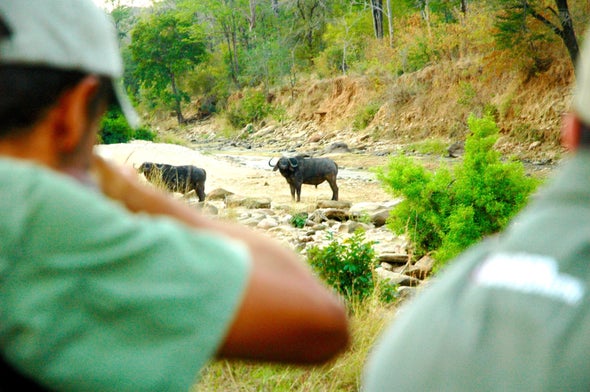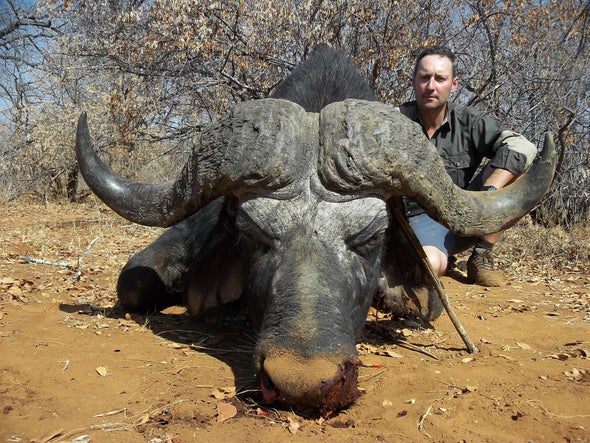Here’s to Hard Decisions
Wide or Old–What Makes a Good Cape Buffalo?
By Dave Fulson • Nov 16, 2025
Of all of Africa's dangerous game, no other species has had the amount of lead, ink, or film thrown his way than the black, mud-covered mountain of muscle we know as the Cape buffalo. He is a creature I have hunted extensively with both rifle and video camera across most of his current ranges, and he has both thrilled me and frankly scared the hell out of me more times than I care to count.

In addition to hunting him, I have sold hunts for Cape buffalo a couple of hundred times, maybe many more, over the years in my role as a safari booking agent. Our company, Safari Classics Productions, has been in the buffalo business for a long time. We have enhanced interest in this grand species with two television series dedicated to the dangerous game of Africa, as well as three documentary films currently dedicated to the hunt for the Cape buffalo.
As a bull grows, the spongy gray skin above his eye begins to harden into what will become his weapon of choice, a battering ram that, when hardened, is known as the boss.
In discussions with prospective buffalo clients, one question, without fail, comes into the conversation: "How big are your buffalo?" With the complete ease of a well-polished wise guy, I will usually say, "Well, if the rains were good, and there is plenty of grass, a big one will weigh around 1,700 pounds, give or take." The awkward pause is soon followed by, "No... I mean, how wide are the buffalo in your area?"
And I am not alone. Every booking agent and safari operator must answer this question countless times in their career, which is, of course part of the job. Certainly, buffalo hunters want to leave Africa with a buffalo they will be proud of, and I am no exception. But the answer to "what makes a good buffalo" is quickly changing. And for good reason.
Certainly, a wide bull catches your attention quickly, be it through your rifle scope, in a photo, or in someone's game room. But all too often, a wide bull is not necessarily a mature bull. Experienced PH’s agree—no matter how wide a bull is, unless he is fully mature, he should not be considered a shooter.
There is no doubt that genetics will play a role in the development of a bull's boss, width, and overall horn configuration. Although there are exceptions, the buffalo of East Africa tends to see more drop in the horns as a bull matures than the buffalo of South Africa, which tend to flare out more, although often at the expense of a looping drop. The buffalo of Zimbabwe and Mozambique are somewhere in the middle. But there are always exceptions.
As a bull ages, the spongy material will harden, becoming a completely solid structure that usually, but not always, meets in the middle of the forehead. By eight years of age, the average bull will have a fully developed boss. Some bosses will be raised up high off the forehead and are very impressive. Some are extremely flat, only raising an inch or so off the skull. The widest bull I have ever seen measured a colossal 18 inches from front to back! Most are between 12–13 inches wide.
But the boss is not what catches the untrained eye. No, buffalo hunters worship at the altar of width. Unfortunately, so do the most popular record books. Forget the width for a second and focus on the next best indicator of a younger vs. older bull—the horn tips. These can provide two indicators of maturity: 1) their height either above or below the top of the boss, and 2) the wear of the horn tips.
Younger bulls’ horns begin to form a defined curl as the horns start to spread outward. They will eventually end in two pencil-sharp points. On an immature buffalo, the tips will usually, but not always, be well above the line of the top of the boss, whether the bull is 34 or 44inches wide. As the buffalo ages, the horns will begin to drop downward, lowering the level of the horn tips. Horn tips well above the boss generally mean you are looking at a bull that has not reached full maturity, no matter what he scores. Again, there can be exceptions, especially on bulls in the southernmost parts of their range.

A surefire indicator of advanced age are the horn tips themselves. A bull begins to wear down his tips in his lifetime of tussles with other bulls, as well as his habit of rubbing trees and concrete-hard termite mounds as he prepares both mood and body for the rigors of adulthood, especially turf wars that lead to fights over breeding rights. Older bulls often grind their tips down to a point that more resembles the end of a baseball bat. That is a dead giveaway to an old, fully mature bull. Find that kind of buffalo, and you are in business!
Of course, the buffalo hunter’s dream bull has it all. He has a pronounced and rock-hard boss. His horns will sport a deep and attractive curl, and his tips will be well-worn. Finally, he will be breathtakingly wide, and the number of candles on his last birthday cake will make it hard to blow out. They are out there, but not all of us will find that bull, even over multiple safaris. He's not yet on my wall, that's for sure!
I recommend hunters go for the old bull—a fully mature specimen that has passed his genes down to his many sons. He will have a collection of lion stories that would fill a book, and chances are, blood, both his and theirs, has been spilled in epic battles in lonely pieces of bush. The hunt for him will be your ultimate trophy if your head is on straight. Inches and score sheets will be forgotten as the years roll by, but not the memories.
Many times, in private moments, you will recall the flutter in your gut as the trackers slowed to a crawl after hours unwinding and following his tracks, and how your PH whispered, “We’re close, so stay right with me.” You will recall when tiny sounds, such as your feet lightly stepping through the grass, seemed to resemble a bulldozer going through a picket fence. You will remember the split second when you realized that the coming confrontation—and, trust me, it will feel more like a confrontation than an opportunity—will be squarely on your shoulders. If all went right, the sticks came up, you settled your rifle into their secure cradle as you saw a magnificent old bull turning to face you. You don't remember the sound of the shot, or the crunch of recoil, but you will never forget that wonderful thump that came back to you the instant before the bull exploded from heavy cover.

If you are lucky, and your aim was good, a never-to-be-forgotten and utterly sad, haunting bellow will come from the direction of the bull.
You’ve read the books and seen the DVD’s and you think you know what the sound means. But all the same, you follow your PH into the cover, one step at a time, until he stops, levels his big double rifle, and tells you to ease up beside him. Twenty yards is a buffalo bull on the ground, stretched out and motionless. You were told to put in a shot into the spine, in the middle of the massive shoulders, which you did. All is now quiet, but something magical has suddenly happened. The bull on the ground is no longer a buffalo. No, it is now and forever more your buffalo. And you will never be the same again.
Some things definitely do not improve with age, but thankfully, Cape buffalo bulls do! Immature animals, of any species, taken before full maturity should never be the goal, even though their genetics might give them enough horn, antler size or length of pelt to make them record book candidates. European hunters tend to place far greater value on age than any other factor, and on that subject at least, I think they have it right.
The Cape buffalo is one of hunting’s most rewarding yet challenging endeavors. If you decide to play this game, do so for the experience it provides; that is the real trophy of this adventure. If you seek out a veteran ‘Dagga Boy,’ no matter the spread or number on some score-sheet, you will have earned membership into a very special fraternity, all of whose most senior and experienced members will tell you “Bloody good show; now that’s the perfect buffalo!"
Stories, Strategy & Safari Wisdom
Go beyond the screen with Dave Fulson’s most insightful writings from over the years.
Each article brings you closer to the skills, stories, and mindset of true African hunting.